Global Quality Management System (G-QMS) in Systems of Systems (SoS)—Aspects of Definition, Structure and Model
Abstract
:1. Introduction
1.1. Rationale
1.2. Background and Relevance
1.3. Purpose
2. Literature Review
2.1. What Is QMS and Its Motivation in Organization?
2.2. QMS in Complex and Global Organizations
2.3. Global Quality Management System (G-QMS)
2.4. SoS Organizations
2.5. Systems Thinking and the Systemic Approach
2.6. Two Additional Aspects When Developing G-QMS in SoS Organizations
- (a)
- System Approach and System Maturity in G-QMS
- (b)
- Reference to the Sectoral QMS Standards
3. Methodology and Research Design
3.1. Methodology
3.2. Research Design
3.2.1. Exploratory Study
3.2.2. Data Analysis
4. Results
4.1. Quantitative View of the Four Levels Content Analysis
4.2. Final Results
- Motivation and need for G-QMS: G-QMS in global SoS organizations has not been defined and formalized, although there are QMS applications in these organizations, which do include some aspects of globalization. According to all of the experts there is a great need for this. They all stated explicitly that it is very important to develop a G-QMS for global SoS organizations. The terms they used included “necessary condition” and “most important.”
- G-QMS structure requires a CORE: The idea that the structure of the G-QMS must include a Cooperate Management Center (CORE) is very powerful. The CORE of the G-QMS should include a high level of expertise in quality management, and have defined control and reporting channels. This cornerstone, in the structure of any G-QMS to be defined, was emphasized by all of the experts. Figure 7 illustrates this structure.
- Homogeneity and a common language: G-QMS must establish a common language that includes common terms for the coordination and operation of the G-QMS. For example, setting a known, accepted assessment scale for Quality rates (and thus for the control and reporting channels) between the G-QMS’s CORE and QMSs of all constituent systems organizations. Homogeneity and common language are the basis for common processes. A G-QMS that includes common processes (although not necessarily to all of its processes) will lead to a stronger G-QMS array (common processes are both critical and challenging for a global organization). Other derivatives of this idea include the creation of basic conditions for G-QMS, one of which is defining a set of basic requirements for each constituent system of the SoS, beyond which concrete extensions can be defined per constituent system.
- Balance—combination of heterogeneity and homogeneity: Most of the experts frequently and vigorously raised a structural point, namely that an interwoven G-QMS structure is required to balance the homogeneity and heterogeneity of the QMSs of the various constituent systems, which they called a key or critical idea. The balance between striving for uniformity and preserving heterogeneity must be determined, along with balancing the defined function between the G-QMS CORE and the QMS of the constituent system.
- Integrating a maturity model in G-QMS: The ISO standard model for certification (dichotomous model 0/1) is no longer suitable for G-QMS arrays, and a more extended model is required to support the complexity and scope of G-QMS activity. The idea of incorporating a model that determines maturity levels for an array—e.g., the CMMI, EFQM and similar—was raised directly by most experts. The rating of maturity model can focus on the QMSs rating of each of the constituent system in the SoS, as well as rating the global and aggregate level of the G-QMS.
- Management and leadership: Management involvement, leadership and commitment are two of the quality management principles that form the basis of the ISO standards, which were also mentioned strongly as a condition for effective implementation of the G-QMS.
- Audits as a tool in G-QMS: The idea that the “ISO standard for QMS as a framework to be extended for G-QMS” is included in point 11, below. However, one of the framework tools—external and internal audits—stood out in its level of intensity and in the number of experts who referred to it. The use of external and internal audits could potentially be very significant for functional expansion, as a balancing tool and a common language for assessment, supervision and control, as well as for exchanging knowledge and information.
- Classification of constituent systems in SoS: An interesting and important idea that arose concerning the basis of the G-QMS model is the classification of the QMSs of the constituent systems in the SoS, with regards to the level of their functional centrality in SoS and their level of complexity. We will elaborate on this idea in sub-Section 5.2.4 of the Discussion. This idea also integrates with others that point to the need for balance in the heterogeneous array of G-QMS depending on the nature of the constituent systems of the SoS as well as the nature of the SoS itself.
- ISO for QMS is limited and doesn’t satisfy for G-QMS: The idea that current ISO standards are inadequate for G-QMS in global SoS organizations was stated with great emphasis by three quality management experts, and also received the highest number of repetitions (15, see Figure 6). Indeed, the standards were said to include many limitations regarding the description and requirements needed for G-QMS. One of the limitations raised directly by two experts is that ISO standards do not address the commonality (uniformity) of the QMS, rather they are self-adapting to any organization. The result is that organizations that are certified to the same ISO standard might actually have different QMSs. The certification model does not facilitate distinction as a basis for comparison among the QMSs of various organizations. Thus, for example, a G-QMS array based on these standards for the QMSs of the constituent systems of the SoS will not be able to work on this basis alone, and will need additional mechanism/requirements. Two further examples of the limitations of the current ISO standards, which are mentioned in general only. First, the most general requirement to comply with “applicable statutory and regulatory requirements” (clause 4.2 in [2]). This requirement is inadequate even for the QMS of a local organization, and for G-QMS—where the issue of compliance with any law is even more complex it is even less adequate. Second, the requirements set for design and development (clause 8.3 in [2]) are also unsatisfactory, necessitating further reference to global SoS.
- The need for coordination: Coordination is a necessary, basic condition for the G-QMS model in global SoS organizations. G-QMS must coordinate with all the QMSs of the constituent systems in the SoS, around the global. This is a particularly important basic condition due to the range of potential G-QMS structures, depending on the nature of the SoS. At minimum there must be coordination between the G-QMS’s CORE and the QMSs of each of the constituent systems. This is a basic condition that the system cannot function without. Coordination is also a component in the basis of abovementioned cross-categories (2), (3), (4), and (9).
- ISO standard for QMS as a framework to be extended for G-QMS: G-QMS can be effectively expanded based on the framework of ISO standards, which could provide very significant added value to any G-QMS model that will be developed. This means that the methods and tools which are considered as groundwork requirements of the ISO standards remain highly relevant in a G-QMS, with the required adjustments.
- G-QMS structure requirement for a quality manager in constituent systems: Another aspect that relates to the structure required for G-QMS regards the management of QMS in each of the constituent systems in the SoS. Quality management of the QMS that works on behalf of G-QMS’s CORE, and be built on professionalism in the field of quality management, as well as a professional understanding (in terms of technology and practice) of the system.
- Inclusion of culture in G-QMS: Any G-QMS model must include reference to the complex organizational culture that results from globalization. While currently, there is no reference to culture anywhere in ISO standards.
- G-QMS requires professionalism: G-QMS must be professional, with significant knowledge in order to be able to add value to the SoS in its field. Professionalism is especially essential when dealing with highly technologically complex, SoS systems. Quality management is required for the management of a set of processes built in accordance with the product technology, therefore professionalism is an important and critical factor.
- The need for high level requirements: The G-QMS model in global SoS organizations should rely not only on the basic condition of coordination, but also include a set of high-level requirements that all constituent systems must meet. This creates boundaries, but constituent systems can still “play” within the limits set by the SoS.
- Emphasis on the G-organizational context and interested parties: A central, critical issue for defining and structuring a G-QMS is how the context of the organization and its interested parties is addressed. These issues exist in ISO 9001 and are even extended in ISO 9004. However, when it comes to the G-QMS the context of the organizational and interested parties are greater and more complex. Therefore, addressing these issues appropriately will shape the contribution required from G-QMS: defining the scope of the G-QMS array, its boundaries, its environment, as well as the set of G-QMS processes and the interrelationships between them. This idea was raised directly and very seriously by two experts, and also appeared as part of additional statements. For instance, the principle of Hierarchy, one of the main principles in the Systems Thinking discipline, is relevant to this context, and was mentioned twice with Significance level 5—“Very High”.
- Systems Thinking: the 5th discipline: Indeed, the Systems Thinking perspective and principles can be relevant and contribute to the development of G-QMS in global SoS organizations. They should be used as a framework for the development of the G-QMS, and thus contribute their advantages and strengths.
- Multiple definitions for SoS: SoS has multiple definitions, and there is no consensus about them, as we conclude from the comments of the two SoS experts. This is consistent with the literature that does not yet present a single agreed (official) definition for SoS [19].
5. Discussion: Insights into the Definition, Structure and Model of the G-QMS
5.1. Definitions and Terminology
5.2. Content and Structure (Model) of G-QMS in Global SoS Organizations
5.2.1. A Cornerstone of the G-QMS Structure
5.2.2. Balance between the G-QMS’s CORE and the QMS: A Critical Component
5.2.3. G-QMS: Heterogeneous Not Homogeneous
5.2.4. Classification of the QMSs of the Constituent Systems
5.2.5. Structures of the ISO Standards as a Framework to Be Extended for G-QMS
5.2.6. The Expansion of the ISO Standards Framework
5.2.7. Systems Thinking Approach as a Framework for G-QMS
5.2.8. Dynamic across Sequence-Scales
5.3. Model of the G-QMS in Global SoS Organizations
6. Summary and Contributions
6.1. Study Limitations
6.2. Directions for Future Studies
Author Contributions
Funding
Conflicts of Interest
References
- Gorod, A.; Sauser, B.; Boardman, J. System-of-Systems Engineering Management: A Review of Modern History and a Path Forward. IEEE Syst. J. 2008, 2, 484–499. [Google Scholar] [CrossRef]
- International Organization of Standardization. ISO 9001:2015 Quality Management Systems—Requirements; ISO: Geneva, Switzerland, 2015. [Google Scholar]
- International Organization of Standardization. ISO 9004:2018 Quality Management—Quality of an Organization—Guidance to Achieve Sustained Success; ISO: Geneva, Switzerland, 2018. [Google Scholar]
- Bashan, A.; Notea, A. A hierarchical model for quality management systems in global organizations. Int. J. Qual. Reliab. Manag. 2018, 35, 1380–1398. [Google Scholar] [CrossRef]
- Guide to the Systems Engineering Body of Knowledge (SEBoK), Version 2.2. 2020. Available online: http://www.sebokwiki.org (accessed on 30 August 2020).
- Monat, J.P.; Gannon, T.F. What is Systems Thinking? A Review of Selected Literature Plus Recommendations. Am. J. Syst. Sci. 2015, 4, 11–26. [Google Scholar]
- Farazmand, E.; Moeini, A.; Sohrabi, B. Main Categories of Information Technologies Systems Regarding Process Orientation and Knowledge Orientation. In Proceedings of the 6th WSEAS International Conference on Mathematics and Computers in Business and Economics (MCBE’05), Buenos Aires, Argentina, 1–3 March 2005; D’Attelis, C., Saint-Nom, R., Mastorakis, N., Eds.; WSEAS Press: Athens, Greece, 2005. [Google Scholar]
- McCormack, K. Business Process Orientation: Do you Have It! Qual. Prog. 2001, 34, 51–58. [Google Scholar]
- Srinivasan, A.; Kurey, B. Creating a culture of quality. Harv. Bus. Rev. 2014, 92, 23–25. [Google Scholar] [PubMed]
- Mehra, S.; Agrawal, S.P. Total quality as a new global competitive strategy. Int. J. Qual. Reliab. Manag. 2003, 20, 1009–1025. [Google Scholar] [CrossRef]
- Kim, K.Y.; Chang, D.R. Global Quality Management: A Research Focus. Decis. Sci. 1995, 26, 561–568. [Google Scholar] [CrossRef]
- Bashan, A.; Armon, B. Quality management challenges in a dynamic reality of mergers, acquisitions and global expansion. Int. J. Qual. Reliab. Manag. 2019, 36, 1192–1211. [Google Scholar] [CrossRef]
- Troshkova, E.V.; Levshina, V.V. Quality Management System of Complex Economic Entity as Organizational Innovation. Int. J. Qual. Res. 2018, 12, 193–208. [Google Scholar]
- Barabasi, A.L.; Frangos, J. The New Science of Networks Science of Networks; Basic Books: New York, NY, USA, 2014. [Google Scholar]
- Keating, C.; Rogers, R.; Unal, R.; Dryer, D.; Sousa-Poza, A.; Safford, R.; Peterson, W.; Rabaldi, G. Systems of Systems Engineering. Eng. Manag. J. 2003, 15, 36–45. [Google Scholar] [CrossRef]
- Maier, M.W. Architecting Principles for Systems-of-Systems. Syst. Eng. 1999, 1, 267–284. [Google Scholar] [CrossRef]
- Kotov, V. Systems of Systems as Communicating Structures; Hewlett Packard: Palo Alto, CA, USA, 1997. [Google Scholar]
- Albers, A.; Mandel, C.; Yan, S.; Behrendt, M. System of Systems Approach for the Description and Characterization of Validation Environments. Int. Des. Conf.-Des. 2018, 2799–2810. [Google Scholar] [CrossRef]
- Eisner, H.; Marciniak, J.; McMillan, R. Computer-aided system of systems (C2) engineering. In Proceedings of the IEEE International Conference on Systems, Man and Cybernetics, Charlottesville, VA, USA, 13–16 October, 1991. [Google Scholar]
- Eisner, H.; McMillan, R.; Marciniak, J.; Pragluski, W. RCASSE: Rapid computer-aided systems of systems (S2) engineering. In Proceedings of the INCOSE 3rd International Symposium Engineering, Crystal City, VA, USA, 26–28 July 1993; pp. 267–273. [Google Scholar]
- Shenhar, A.J. A new systems engineering taxonomy. In Proceedings of the 4th International Council on Systems Engineering, St. Louis, MO, USA, 22–26 July 1995; pp. 723–732. [Google Scholar]
- Shenhar, A.; Sauser, B. Systems engineering management: The multidisciplinary discipline. In Handbook of Systems Engineering and Management, 2nd ed.; Wiley: New York, NY, USA, 2008. [Google Scholar]
- International Organization of Standardization. ISO/IEC/IEEE 21839:2019 Systems and Software Engineering—System of Systems (SoS) Considerations in Life Cycle Stages of a System; ISO: Geneva, Switzerland, 2019. [Google Scholar]
- Azarnoush, H.; Horan, B.; Sridhar, P.; Madni, A.M.; Jamshidi, M. Towards optimization of a real-world robotic-sensor system of systems. In Proceedings of the World Automation Congress (WAC), Budapest, Hungary, 24–26 July 2006. [Google Scholar]
- Department of Defense. System of Systems, Systems Engineering Guide: Considerations for Systems Engineering in System of Systems Environment; Department of Defense: Washington, DC, USA, 2017.
- Jamshidi, M. Systems of Systems Engineering–Innovations for the 21st Century; Wiley: Hoboken, NJ, USA, 2009. [Google Scholar]
- Bertalanffy, L. General System Theory; John Wiley Sons: New York, NY, USA, 1968. [Google Scholar]
- Senge, P.M. The Art and Practice of the Learning Organization; Doubleday: New York, NY, USA, 1990. [Google Scholar] [CrossRef]
- Cabrera, D.; Colosi, L.; Lobdell, C. Systems Thinking. Eval. Program Plan. 2008, 31, 299–310. [Google Scholar] [CrossRef] [PubMed]
- Boardman, J.; Sauser, B. Systems Thinking: Coping With 21st Century Problems; Taylor & Francis: Boca Raton, FL, USA, 2008. [Google Scholar]
- Checkland, P.B. Systems Thinking, Systems Practice; John Wiley & Sons: Chichester, UK, 1981. [Google Scholar]
- Anderson, V.; Johnson, L. Systems Thinking Basics from Concepts to Causal Loops; Pegasus Communications, Inc.: Cambridge, UK, 1997. [Google Scholar]
- Richmond, B. An Introduction to Systems Thinking with iThink; ISEE Systems, Inc.: Lebanon, NH, USA, 2004. [Google Scholar]
- Ackoff, R.L.; Addison, H.J.; Carey, A. Systems Thinking for Curious Managers; Triarchy Press Limited: Axminster, UK, 2010. [Google Scholar]
- Davidz, H.L.; Nightingale, D.J. Enabling Systems Thinking to Accelerate the Development of Senior Systems Engineers. Syst. Eng. 2008, 11, 1–14. [Google Scholar] [CrossRef] [Green Version]
- Arnold, R.D.; Wade, J.P. A definition of systems thinking: A systems approach. Procedia Comput. Sci. 2015, 44, 669–678. [Google Scholar] [CrossRef] [Green Version]
- Bashan, A.; Kordova, S. Globalization, quality and systems thinking: Integrating global quality Management and a systems view. Heliyon 2021, 7, e06161. [Google Scholar] [CrossRef] [PubMed]
- SAE International. Aerospace Standard, AS9001-Quality Management Systems-Requirements for Aviation, Space, and Defense Organizations; SAE: Warrendale, PA, USA, 2016. [Google Scholar]
- International Organization of Standardization. ISO 13485:2016 Medical Devices—Quality Management Systems—Requirements for Regulatory Purposes; ISO: Geneva, Switzerland, 2016. [Google Scholar]
- International Organization of Standardization. ISO/TS 22163:2017 Railway Applications—Quality Management System—Business Management System Requirements for Rail Organizations: ISO 9001:2015 and Particular Requirements for Application in the Rail Sector; ISO: Geneva, Switzerland, 2016. [Google Scholar]
- IATF-International Automotive Task Force. IATF16949:2016–Quality Management Systems Standard for the Automotive Industry; IATF: Southfield, MI, USA, 2016. [Google Scholar]
- Glaser, B.G.; Strauss, A.L. The Discovery of Grounded Theory: Strategies for Qualitative Research; Transaction Publishers: Piscataway, NJ, USA, 2009. [Google Scholar]
- Sabar Ben Yehoshua, N. Qualitative Research in Teaching and Learning; Modan: Ben Shemen, Israel, 1995. [Google Scholar]
- Demeter, K. Research in Global Operations Management: Some Highlights and Potential Future Trends. J. Manuf. Technol. Manag. 2017, 28, 324–333. [Google Scholar] [CrossRef]
- Office of the Director, Defense Research and Engineering, Director of Systems Engineering. Systems Engineering Guide for Systems of Systems: Summary; Defense Pentagon: Washington, DC, USA, 2010.
- Valerdi, R.; Rouse, W.B. When Systems Thinking Is Not a Natural Act. In Proceedings of the 2010 IEEE International Systems Conference, San Diego, CA, USA, 5–8 April 2010. [Google Scholar] [CrossRef] [Green Version]
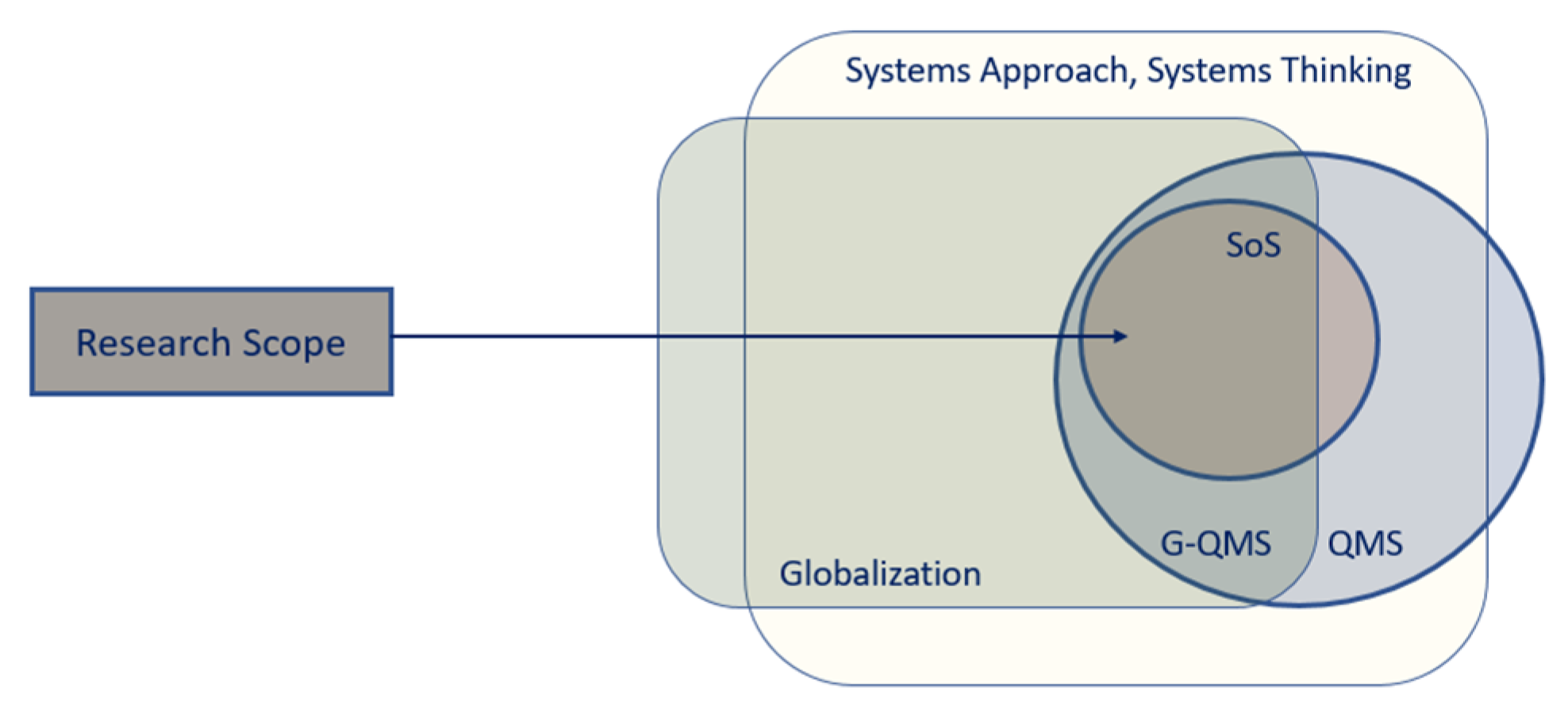
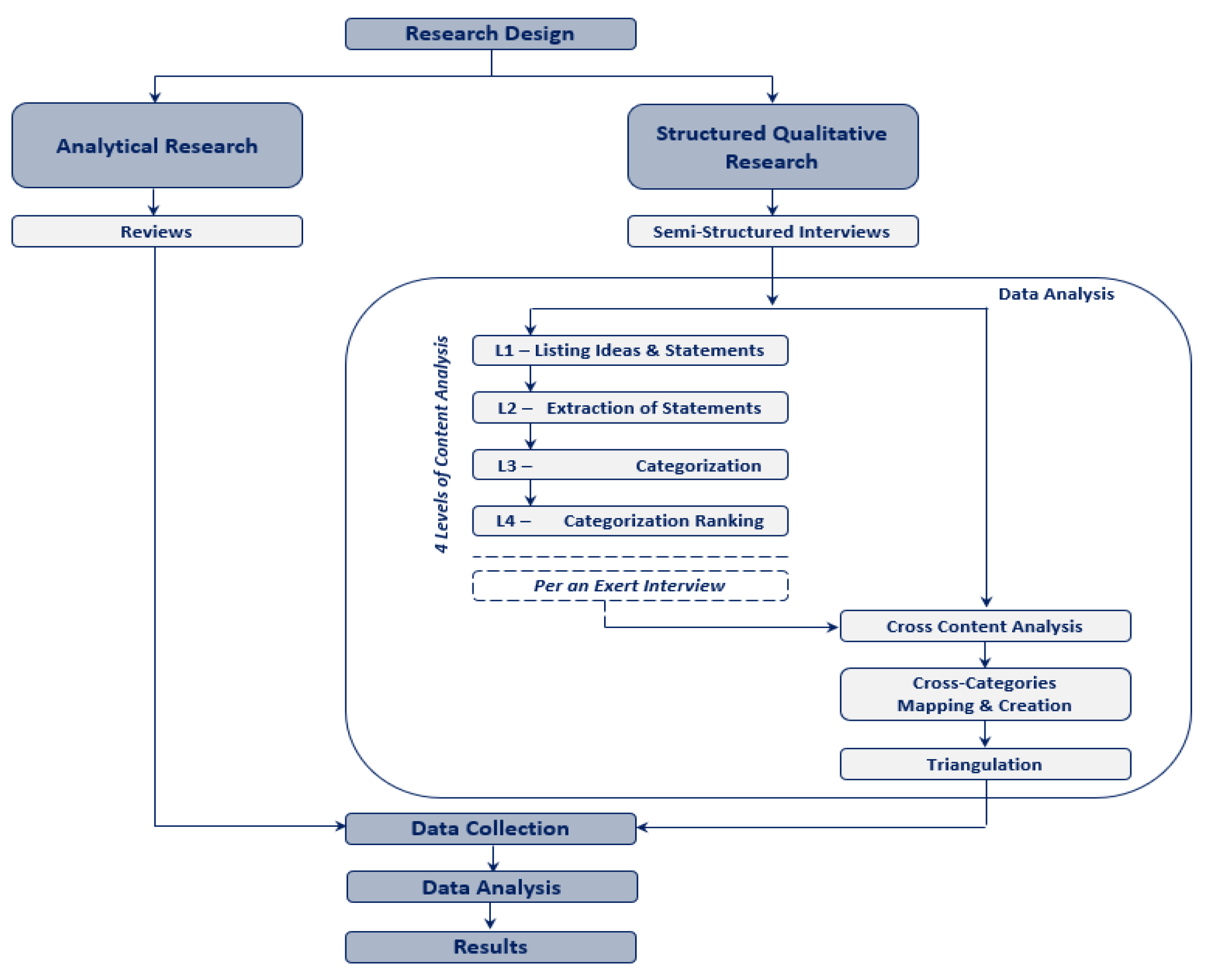

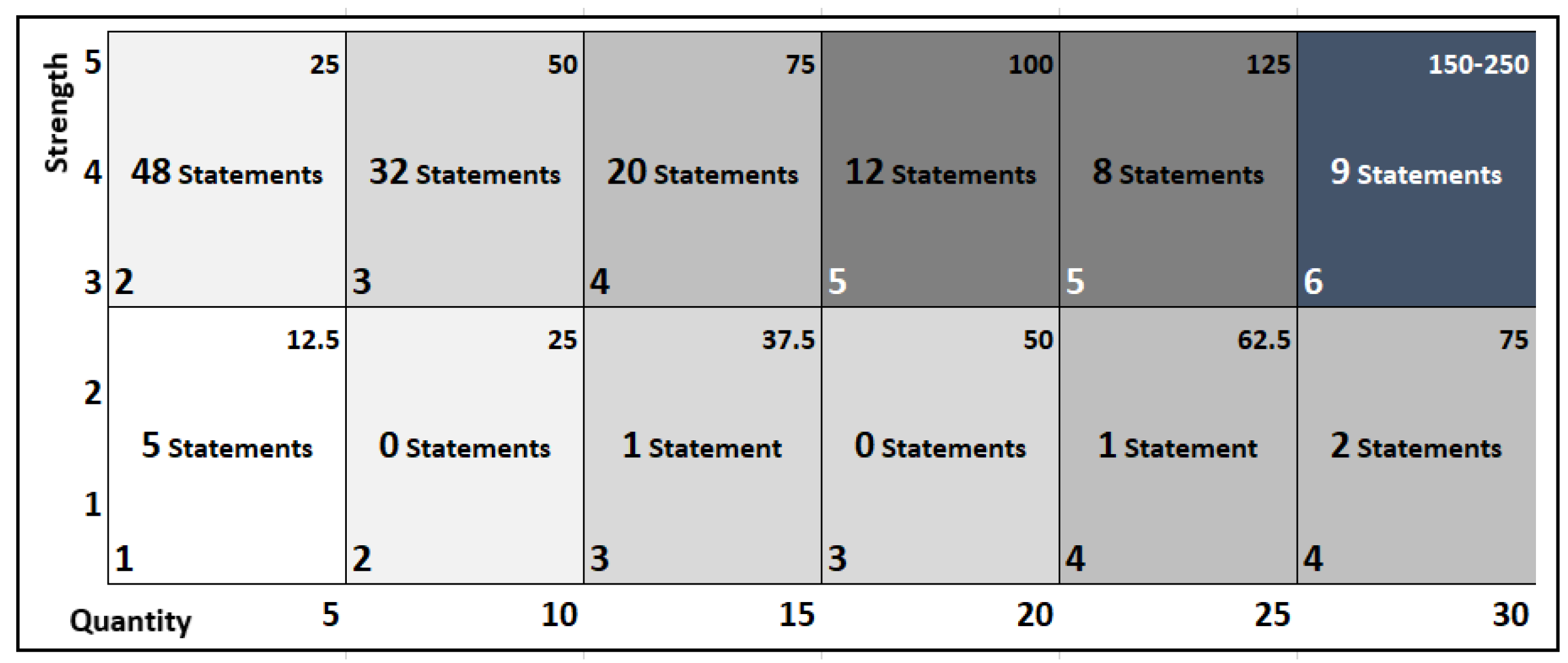
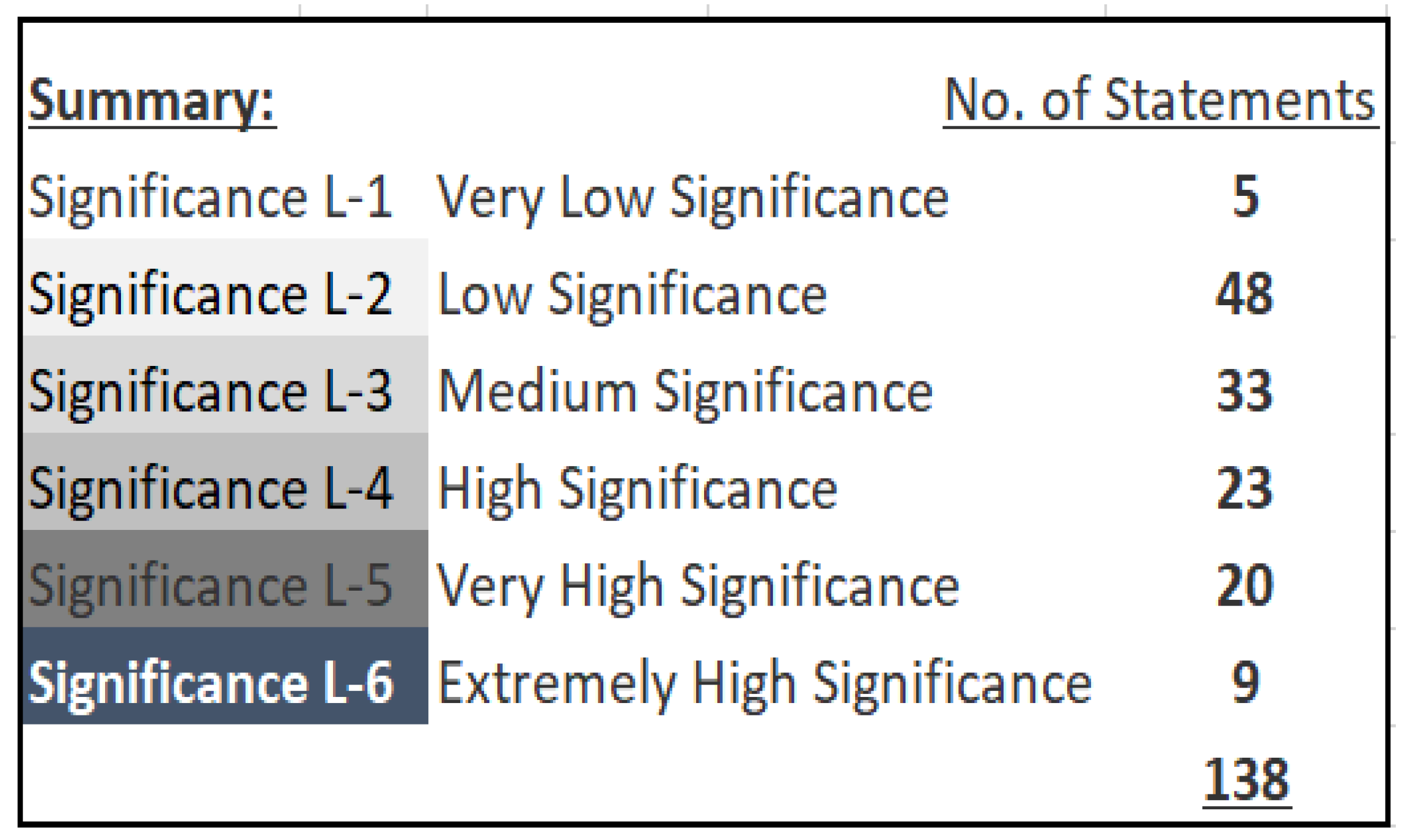
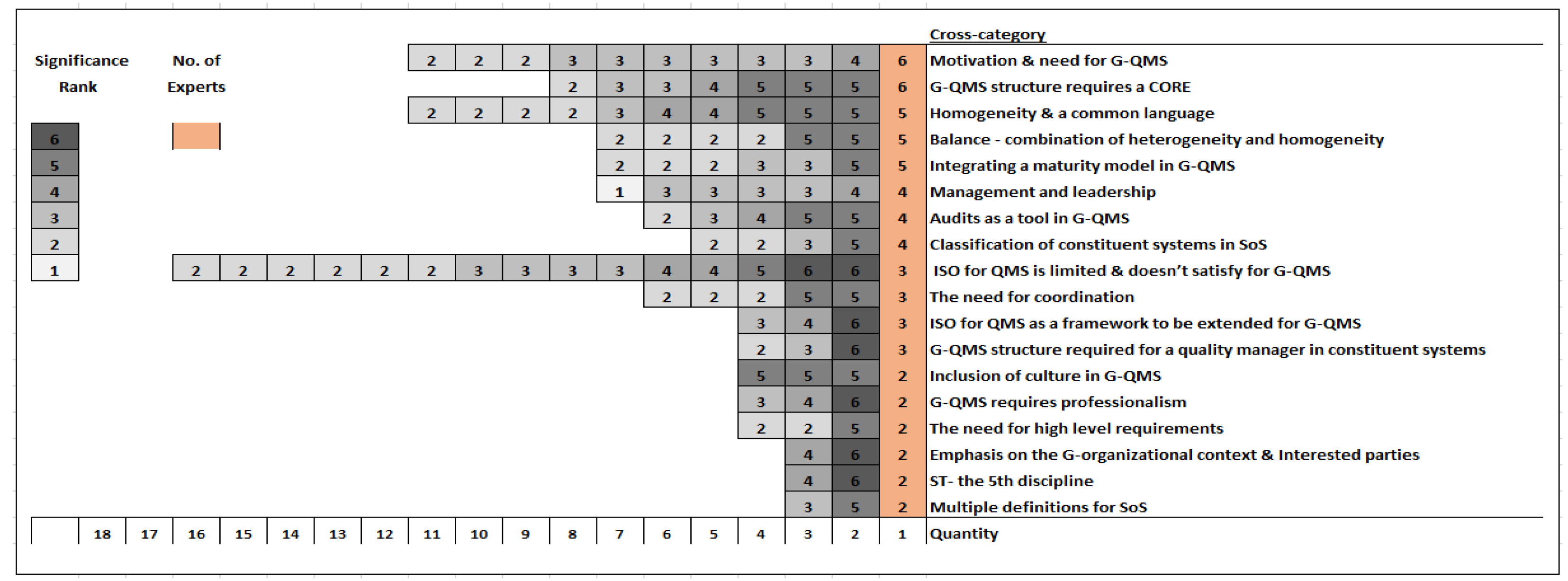

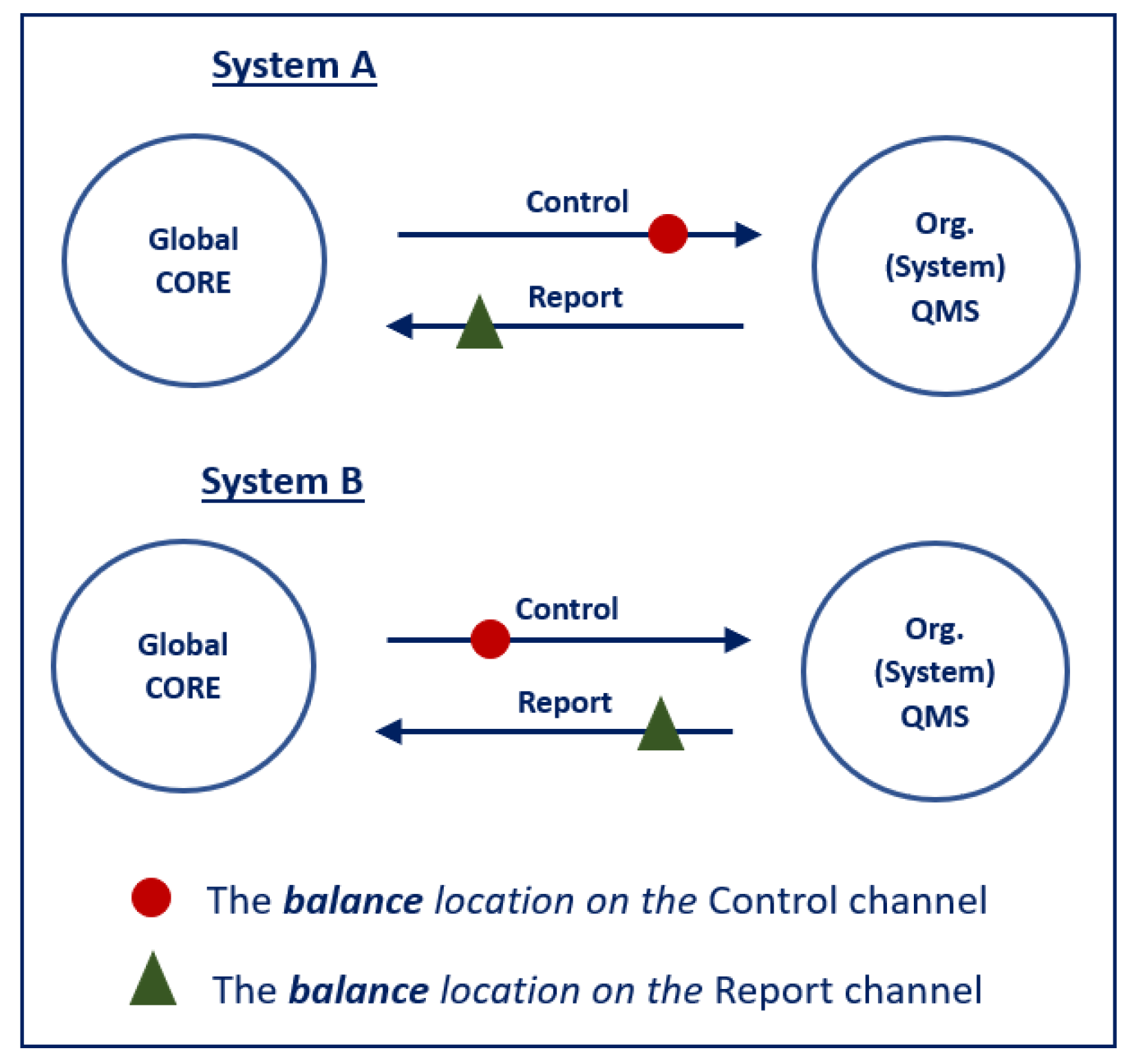

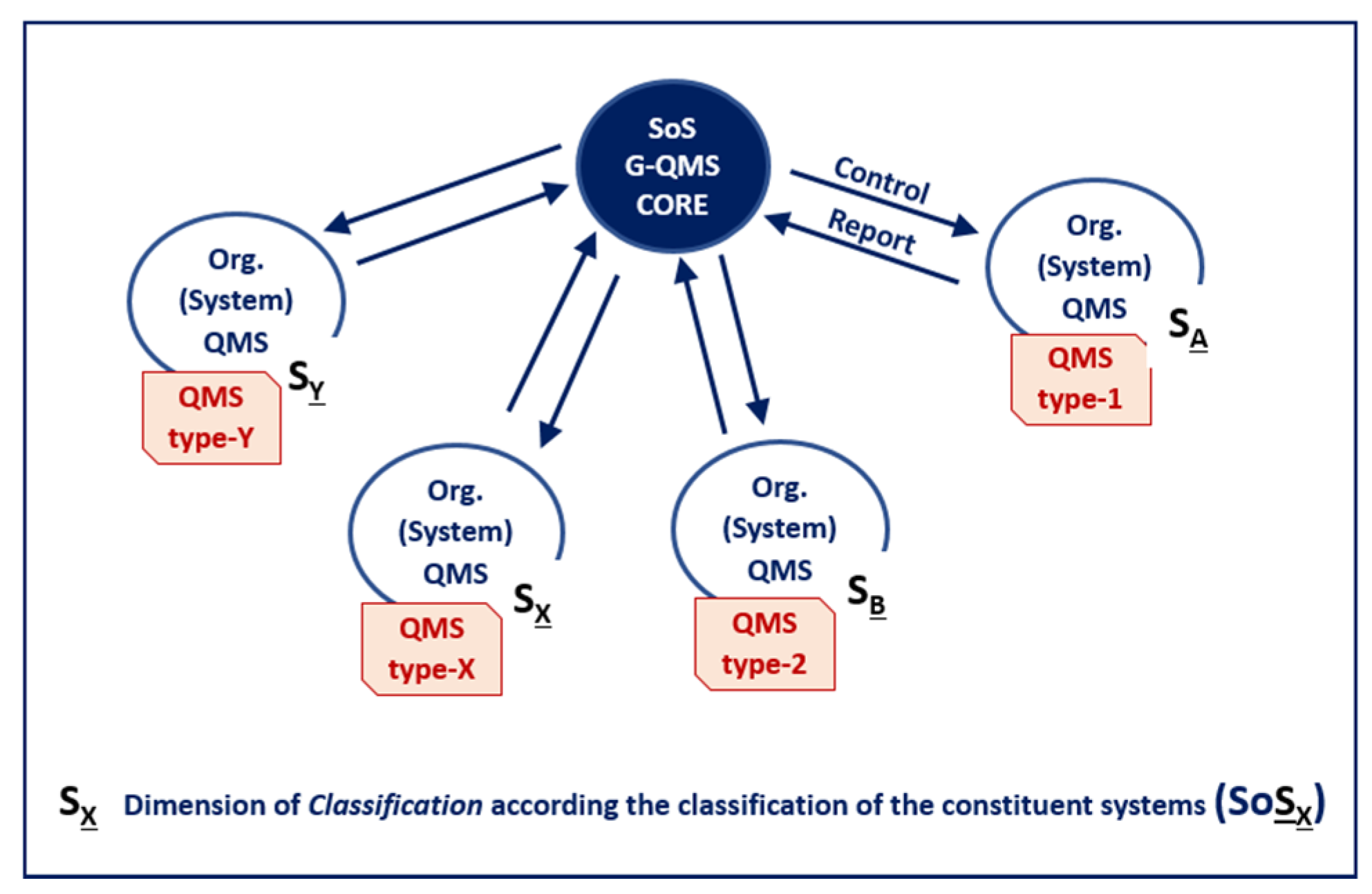
Publisher’s Note: MDPI stays neutral with regard to jurisdictional claims in published maps and institutional affiliations. |
© 2022 by the authors. Licensee MDPI, Basel, Switzerland. This article is an open access article distributed under the terms and conditions of the Creative Commons Attribution (CC BY) license (https://creativecommons.org/licenses/by/4.0/).
Share and Cite
Agmon, N.; Kordova, S.; Shoval, S. Global Quality Management System (G-QMS) in Systems of Systems (SoS)—Aspects of Definition, Structure and Model. Systems 2022, 10, 99. https://doi.org/10.3390/systems10040099
Agmon N, Kordova S, Shoval S. Global Quality Management System (G-QMS) in Systems of Systems (SoS)—Aspects of Definition, Structure and Model. Systems. 2022; 10(4):99. https://doi.org/10.3390/systems10040099
Chicago/Turabian StyleAgmon, Noga, Sigal Kordova, and Shraga Shoval. 2022. "Global Quality Management System (G-QMS) in Systems of Systems (SoS)—Aspects of Definition, Structure and Model" Systems 10, no. 4: 99. https://doi.org/10.3390/systems10040099
APA StyleAgmon, N., Kordova, S., & Shoval, S. (2022). Global Quality Management System (G-QMS) in Systems of Systems (SoS)—Aspects of Definition, Structure and Model. Systems, 10(4), 99. https://doi.org/10.3390/systems10040099






